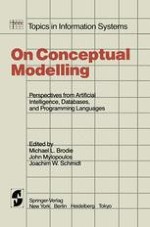The growing demand for systems of ever-increasing complexity and precision has stimulated the need for higher level concepts, tools, and techniques in every area of Computer Science. Some of these areas, in particular Artificial Intelligence, Databases, and Programming Lan guages, are attempting to meet this demand by defining a new, more abstract level of system description. We call this new level conceptual in recognition of its basic conceptual nature. In Artificial Intelligence, the problem of designing an expert system is seen primarily as a problem of building a knowledge base that repre sents knowledge about an enterprise. Consequently, Knowledge Repre sentation is viewed as a central issue in Artificial Intelligence research. Database design methodologies developed during the last five years are almost unanimous in offering semantic data models in terms of which the designer directly and naturally models an enterprise before proceed ing to a detailed logical and physical database design. In Programming Languages, different forms of abstraction which allow implementation independent specifications of data, functions, and control have been a major research theme for a decade. To emphasize the common goals of these three research efforts, we call this new activity conceptual modelling.
